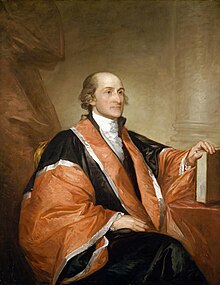Jay Estate
[2][4][5][6] The site is one of two surviving remnants of the 400-acre (1.6 km2) farm where US Founding Father,[7] John Jay (December 12, 1745 – May 17, 1829), grew up, the other intact parcel being the Marshlands Conservancy.[8] It is also the place where Jay returned to celebrate the end of the American Revolutionary War, after he negotiated the 1783 Treaty of Paris with fellow peacemakers John Adams and Benjamin Franklin.[15] A 2013 public-private partnership and agreement awarded stewardship of the State and County's 21.5 acres, including preservation, restoration and interpretation to the Jay Heritage Center (JHC).The Jay Estate is located adjacent to the Marshlands Conservancy, a completely separate nature preserve owned and operated 100% by Westchester County Parks.At 14 years old, Jay went to New York City to study law at Kings College (today's Columbia University) but continued to come home fortnightly to spend time and holidays with family.When the Stamp Act compelled Jay and many other lawyers to strike in defiance of British law, he returned there to live from 1765 to 1766, and immersed himself in re-reading the classics.After Jay's retirement to Bedford, he inherited his brother's portion of the estate and oversaw management of the property from 1813 to 1822 before transferring it to his eldest son Peter Augustus in 1822.Famous visitors to the Jay Estate during this period include Yale President Timothy Dwight IV, American novelist James Fenimore Cooper, artist and inventor Samuel F. B. Morse.Seven years after his father's death, Peter reluctantly took down the ancestral house but reincorporated its timbers, doors, shutters and nails into a new 1838 structure, locating the second construction on the footprint of the first building.Owners of the Jay Estate in modern times included architect Henry Ives Cobb (1904) who purchased the land with hopes to develop it; Dutch financier Warner M. Van Norden and Grace Talcott (1905-1911) who kept rare animals including Highland cattle and Grevy zebras;[22] Princeton benefactor and Palmer Square creator Edgar Palmer and his wife Zilph (1911-1935); National Horse Show President Walter B. Devereux and his wife Zilph (1935-1966);[23] the Methodist Church (1966-1979); and lastly DGM Partners, a real estate concern (1979-1992).During this chapter of change, and upon seeing the preserved landscape and viewshed of John Jay's youth and early adulthood, Justice Harry Blackmun remarked,[25] It was a place that struck me then as symbolic of what was impressive about certain aspects of the latter part of the 18th century—gracious living and status to be sure, but coupled with a sense of responsibility, particularly to government and to the art of getting along together.It is also during this window that the surrounding Boston Post Road Historic District was added to the National Historic Register of Places (1982).[26] To help build consensus for ways to move constructively forward, Birnbaum and Jay Heritage Center co-sponsored a day-long symposium called "Bridging the Nature Culture Divide."[27] In 2013, the non-profit Jay Heritage Center was awarded stewardship of the park under a private-public partnership agreement following legislative approval by Westchester County in 2012.[29] (Owned by JHC) Pieces of the original 18th century house "The Locusts" found within the mansion are also on public view and illustrate sustainable building traditions.(Owned by NYSOPRHP and Westchester County; maintained and operated by JHC) The original estate gardens had wooden pales that were later replaced by stone fences.John Jay is well known for a contradictory legacy of owning enslaved individuals while simultaneously advocating emancipation, serving as the first President of the New-York Manumission Society, and establishing the first African Free School.[13] In November 2008, the PAJ House became the oldest National Historic Landmark structure in New York State to be equipped with an energy-efficient geothermal heating and cooling system.










U.S. Historic districtContributing propertyU.S. National Historic Landmark DistrictRye, New YorkMinard LafeverAsher BenjaminChester HillsFrank A. RookeGreek RevivalClassical RevivalJay Heritage CenterBoston Post Road Historic District (Rye, New York)Boston Post Road Historic DistrictNational Historic Landmark DistrictFounding FatherJohn JayMarshlands ConservancyAmerican Revolutionary WarTreaty of ParisJohn AdamsBenjamin FranklinBoston Post RoadIndigenous peoplesarchaeologicalMount VernonMonticelloThe GrangeMontpelierJohn Jay HomesteadNew York State ParksWestchester CountyDepartment of the InteriorPortrait of John JayGilbert StuartFounding FathersGeorge WashingtonAlexander HamiltonThomas JeffersonJames MadisonColumbia UniversityStamp ActRevolutionary WarSarah Livingston JayWilliamBedfordPeter AugustusTimothy Dwight IVJames Fenimore CooperSamuel F. B. MorsePeter Augustus JayJohn Wesley JarvisJohn Clarkson JayLyceum of Natural HistoryNew York Yacht ClubAlexander Jackson DavisMary Rutherfurd JayPierre JayJunius Spencer Morgan IIHenry Ives CobbPrincetonPalmer SquareSupreme Court Justice Harry A. BlackmunCharles A. BirnbaumThe Cultural Landscape FoundationCentral Park ConservancyPresidio TrustBeyer Blinder Bellegeothermal heatingSave America's TreasuresNelson Byrd Woltz Landscape ArchitectsHurricane SandyAfrican American Heritage Trail of Westchester CountyNew-York Manumission SocietyAfrican Free SchoolHudson River ValleyNational Heritage AreasustainabilityNational Park ServiceGreek Revival architectureAndrew DolkartPath Through HistoryiNaturalistThe SpyGuy Pene du BoisSpookiesW MagazineTory BurchDickinsonHailee SteinfeldSilas HowardList of burial places of justices of the Supreme Court of the United StatesNational Register of Historic PlacesWestchester County, New YorkYouTubeRye City SDRye HSRye Neck SDRye Neck HSRye Country Day SchoolPlaylandDragon CoasterRye Town Park-Bathing Complex and Oakland BeachRye StationSchool of the Holy ChildHarrison, New York2nd Governor of New York1st Chief Justice of the United StatesUnited States Secretary of StateUnited States Secretary of Foreign AffairsUnited States Minister to SpainPresident of the Continental CongressFounding of theUnited StatesContinental AssociationPetition to the KingOlive Branch PetitionCommittee of Secret CorrespondenceNew York ConstitutionThe Federalist PapersJay Court, Chief Justice of the Supreme CourtNew York Manumission SocietyJay–Gardoqui TreatyJay TreatyLetters to the inhabitants of CanadaNew York Circular LetterThe Selected Papers of John JayGovernment House